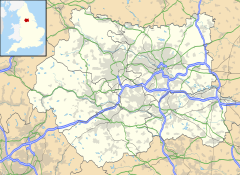Sowerby Bridge
| Sowerby Bridge | |
|---|---|
 Sowerby Bridge skyline |
|
| Sowerby Bridge shown within West Yorkshire | |
| Population | 11,703 (Ward2011) |
| OS grid reference | SE058233 |
| Metropolitan borough | |
| Metropolitan county | |
| Region | |
| Country | England |
| Sovereign state | United Kingdom |
| Post town | SOWERBY BRIDGE |
| Postcode district | HX6 |
| Dialling code | 01422 |
| Police | West Yorkshire |
| Fire | West Yorkshire |
| Ambulance | Yorkshire |
| EU Parliament | Yorkshire and the Humber |
| UK Parliament | |
Sowerby Bridge /ˌsɔːrbi ˈbrɪdʒ/ is a market town in the Upper Calder Valley in Calderdale in West Yorkshire, England. The Calderdale Council ward population at the 2011 census was 11,703.
Always pronounced Sorby Bridge, the town was originally a fording point over the once much-wider River Calder where it joins the River Ryburn. The town takes its name from the historic bridge which spans the river in the town centre. Before the Industrial Revolution the area was divided between the parishes of Sowerby, Norland, Skircoat and Warley. The boundaries between them being the rivers Calder and Ryburn and Warley Clough, which is now largely culverted. Textiles and engineering industry grew up around the bridge. By the mid-19th century the population had grown and the settlement became an urban district in the West Riding of Yorkshire in 1894.
From 1892 to 1930 Pollit & Wigzell manufactured stationary steam engines for the cotton and woollen mills of Yorkshire, Lancashire and India. Wood Brothers, an engineering and millwright company, also produced engines from its Valley Iron Works. The Markfield Beam Engine is an example for its work.
Council buildings on Hollins Mill Lane, the old swimming pool, council offices and fire station will be transferred to the community group, Sowerby Bridge Fire and Water, and will be renovated for community use.
...
Wikipedia

